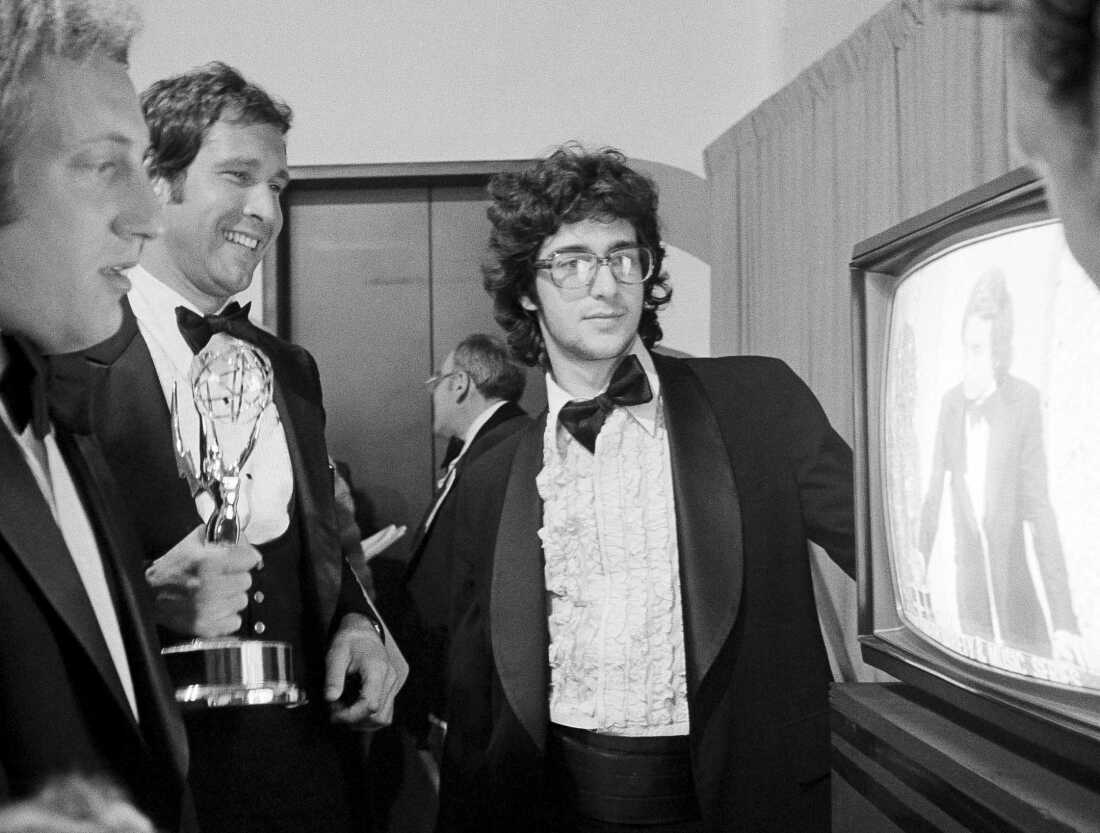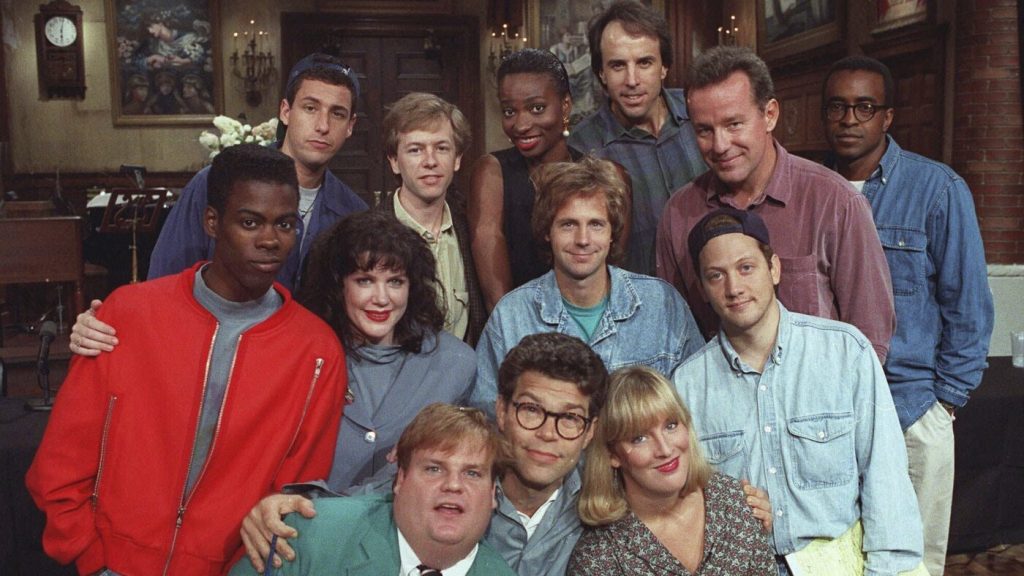
Saturday Night Live is marking its 50th year with a weeklong celebration, including a blockbuster homecoming concert and a three-hour primetime special. Above, SNL cast members pose on the show’s set in September 1992. Front row, from left: Chris Farley, Al Franken and Melanie Hutsell. Middle row, from left: Chris Rock, Julia Sweeney, Dana Carvey and Rob Schneider. Back row, from left: Adam Sandler, David Spade, Ellen Cleghorne, Kevin Nealon, Phil Hartman and Tim Meadows.
Justin Sutcliffe/AP
hide caption
toggle caption
Justin Sutcliffe/AP
Weird as it sounds now, Saturday Night Live‘s 50-year tenure as one of the longest running programs in TV history may have come down to two important decisions made before the show even debuted in 1975.
First, comic Albert Brooks, then considered a rising star among a new breed of comedians, turned down a suggestion to serve as the programs’ permanent host, urging NBC to hire a rotating lineup of guest hosts instead.
And creator and executive producer Lorne Michaels decided against hosting the program’s long-running newscast satire Weekend Update, handing the gig over to star-in-the-making Chevy Chase.
When it debuted — as a live show with unknown performers that replaced reruns of Johnny Carson’s The Tonight Show on Saturdays — few people in showbusiness’ establishment probably thought SNL would last one season, let alone 50.
But, as it prepares to mark its golden anniversary with a weeklong celebration, including a blockbuster homecoming concert and a three-hour primetime special, it’s worth considering several key moments which made it all possible — and a few things they got wrong.
It turned a new generation’s comedy into the backbone of Hollywood
SNL debuted as the scrappy voice of performers determined to develop new styles of comedy beyond the ossified professionalism of Carson’s era. Stocked with young writers, producers and performers, their defiant spirit was summed up in the cast’s original name: The Not Ready for Prime Time Players.
Turns out, a 90-minute sketch comedy show featuring live performances was a masterstroke — as long as the cast included talents like Chase, John Belushi, Gilda Radner and Dan Aykroyd.

Chevy Chase, center, holds his Emmy Award as he watches producer Lorne Michaels accepting another Emmy for SNL, while writers Alan Zweibel, left, and Tom Davis look on in 1976.
Reed Saxon/P
hide caption
toggle caption
Reed Saxon/P
SNL flourished as the creation of a generation who preferred Richard Pryor to Bill Cosby and could tell the difference between someone who was drunk and someone who was high. Within a few years, early cast members like Belushi and Chase were becoming movie stars and catchphrases or bits coined by the show were quoted by everyday people.
And that drive to build comedy around what people are talking about right now has remained at the center of the show.
According to Susan Morrison, author of the book Lorne: The Man Who Invented Saturday Night Live, around 1990 Michaels “had this realization: ‘Is this going to be a ’70s show that I keep kind of pushing forward into the future … or is it going to be a show that gets reinvented for every generation?”
Morrison adds: “Lorne, I think, was very alert to what I call the hinges between generations. He always wanted smooth transitions. … He’s very conscious of not wanting to look like a grandmother with a Hula Hoop.”
It embraced rotating hosts —
Some critics have compared SNL‘s rotating guest hosts to the way 61-year-old science fiction franchise Doctor Who changes its star character regularly — rejuvenating the show by allowing a new star to interact with a cast viewers know. And, in SNL‘s case, serving up a new celebrity to draw public attention every week.
“The thing about rotating hosts, is that it frees up the writers … you don’t have to be constantly thinking, ‘What is Sonny going to say to Cher this week?'” says Morrison. (She wrote a preview of the material in her book for The New Yorker.)
— and regularly refreshed cast members
Another subtle ability Michaels’ leveraged was his eye for talent — and the willingness to turn over casts to make room for new comedy voices.
SNL alums have formed a who’s who of comedy through five generations, from Chase, Belushi Radner, and Aykroyd to Eddie Murphy, Will Ferrell, Tina Fey, and Bowen Yang. Even people who washed out as staffers — including Chris Rock, Ben Stiller, and Julia Louis-Dreyfus — have gone on to become huge stars elsewhere.
Maureen Ryan, author of the 2023 book Burn It Down: Power, Complicity, and a Call for Change in Hollywood, which explores toxic work environments in entertainment, says the show unites American popular culture and the commercial entertainment industry in a way few other TV shows have managed — turning Michaels into a de facto gatekeeper for Hollywood’s comedy industry.
“Everybody from that show goes on to do something else…whether it’s stand-up [comedy], film, TV, books,” she says. “Lorne Michaels’ army has spread to the four corners of the entertainment world. It’s the farm team for commercial entertainment.”
Forget about finding a good agent or manager to make a mark; in comedy, there are fewer seals of approval more convincing than a staff job at Saturday Night Live.
Michaels became a (mostly) off camera Godfather of American comedy
Over the years, Michaels has developed an image as the preternaturally cool, mostly behind-the-scenes guru and tastemaker, ceding the center spotlight to guide both the most complicated variety show on television and all the ancillary spin-offs across broadcast television, film and elsewhere.
“First of all, someone has to be the boss,” Al Franken, one of the original writers and occasional performers on SNL and a former U.S. senator, told me last year. “He’s a great boss in the sense that he has the authority, has earned it and earned it right away. That’s what it takes, that kind of leadership.”
It’s a long way from Toronto circa 1944, where Michaels was born Lorne Lipowitz — climbing the TV industry by working on shows like Laugh-In and producing specials starring Lily Tomlin, until then-NBC President Herb Schlosser asked him to produce a new live comedy show called Saturday Night.

Lorne Michaels, left, shares a laugh with Jerry Seinfeld during an SNL rehearsal in 1992.
Susan Ragan/AP
hide caption
toggle caption
Susan Ragan/AP
Even comedy nerds may not realize how much of America’s entertainment landscape Michaels now influences. By staying connected to films and TV shows created by people from SNL, he’s become the executive producer or producer on projects including The Tonight Show Starring Jimmy Fallon, Late Night with Seth Meyers, 30 Rock, Three Amigos, Wayne’s World, Mean Girls, the 70th Primetime Emmy Awards, Adele Live in New York, Schmigadoon, Portlandia and much more.
His success hasn’t come from imposing his sensibilities on the shows he oversees. Instead, Michaels has created an atmosphere at SNL where a long procession of talented writers and performers have fought it out to showcase their best work, with the executive producer serving as the savvy, connected father figure/referee to a bustling band of ambitious creatives.
“He’s a guy who lost his father when he was 14,” Morrison says. “I know this sounds kind of like pop psychology, but he was always trying to rebuild a feeling of a family or clubhouse…I think, for him, it just comes down to wanting to discover and nurture young talent. He’s really good at spotting a thing in somebody.”

Lorne Michaels poses with his Emmy for Outstanding Variety/Sketch Series in 2017.
Alberto E. Rodriguez/Getty Images
hide caption
toggle caption
Alberto E. Rodriguez/Getty Images
Now age 80, Michaels’ advancing years raises a powerful question: Who else can muster the balance of show business power and managerial savvy to keep SNL going after him?
Morrison has heard the popular names floated as successors, like Tina Fey and Seth Meyers (Meyers gets my vote, particularly if Michaels steps back at a time when NBC might consider ending his show Late Night). But she’s not sure anyone could truly pull it off.
“The thing is, so much of the show has to do with his mystique, you know, his unpredictable Wizard of Oz-ness,” she adds of Michaels, who she says can be cryptic and hands off as a manager until Saturday, when tough decisions must come over what airs that night. “He seems to me like the most powerful executive at NBC … In terms of a Lorne-free SNL, that’s kind of hard for me to see.”
Yet Michaels — and SNL — has also made mistakes.
It didn’t reflect America’s racial diversity for far too long
One of the saddest ironies of Jason Reitman’s uneven film Saturday Night — a look in real-time at the 90 minutes before the show’s first telecast on Oct. 11, 1975 — is Lamorne Morris’ masterful depiction of the show’s first Black cast member, Garrett Morris (no relation). Almost all his screen time features Morris pleading with the show’s producers to actually use him in a sketch. Instead, he sings a song for the cast and crew at a rehearsal before the actual telecast, proving his worth in a way no TV viewers would see that night.

Eddie Murphy, left, guest host Robin Williams, and Joe Piscopo take a break from rehearsal in February 1984.
Suzanne Vlamis/AP
hide caption
toggle caption
Suzanne Vlamis/AP
That the show would continue to underuse or avoid casting people of color for decades — even after the meteoric rise of Eddie Murphy, who was hired during the five years from 1980 to 1985 that Michaels left SNL — remains a bizarre and troubling oversight. Murphy had proven that comedy mined from Black culture could power classic SNL sketches, but other young Black comics like Damon Wayans and Chris Rock had undistinguished tenures before blowing up as stars elsewhere. Kevin Hart, famously, was not hired after auditioning in 2001.
For years, there had only been two Latino cast members in SNL’s history — Horatio Sanz, who was on SNL from 1998 to 2006, and Fred Armisen from 2002 to 2013.
Bowen Yang is SNL‘s first Asian American cast member — he was first hired in 2018. As a writer.
For years, it also didn’t feature women enough
Tina Fey is credited with turning around SNL‘s long-standing struggle to feature women, elevating ace performers like Amy Poehler, Rachel Dratch and Maya Rudolph during her time as the show’s head writer in the early 2000s.
A handful of Black women also have been performers over the years, but the show was regularly lambasted for not hiring more or featuring them better. In 2014, under a lot of public pressure, Michaels hired three Black women at once — Sasheer Zamata, LaKendra Tookes and Leslie Jones. The first Latina cast member, Melissa Villasenor, was hired in 2016.
It traumatized staffers with a punishing production schedule
SNL‘s punishing production hours are legendary, with writers working around the clock from Tuesday to Wednesday crafting scripts, and staffers working into the wee hours on other days to craft pre-taped videos or refine troublesome sketches. Alums like David Spade have spoken about how they receive very little guidance upon joining the staff, jumping into a sink-or-swim environment where they are expected to learn on the fly.
In her book, Burn It Down, Maureen Ryan collects anecdotes from a wide range of SNL staffers — Janeane Garofalo, Conan O’Brien, Cheri Oteri and Darrell Hammond among them — about the anxiety, fear, fatigue and trauma of working at a show which, as one former staffer told her, “has no institutional interest in helping the people who work there be better at the job.”

Maya Rudolph, left, played U.S. Vice President Kamala Harris during her 2024 presidential campaign.
Charly Triballeau/AFP via Getty Images
hide caption
toggle caption
Charly Triballeau/AFP via Getty Images
While acknowledging that such a Darwinian approach might produce great comedy, Ryan notes, “I do think you would have gotten more and better comedy from a wider array of people with a larger array of viewpoints, had that punishing environment not been, at times, negatively impacting people’s mental health … negatively impacting people who are already historically excluded and marginalized. Everything we’re talking about … it’s much worse for queer people, it’s much worse for women and if you’re not a white dude.”
Such subjects aren’t likely to arise during Saturday Night Live‘s programming to celebrate its 50th anniversary. But they have become part of the complicated legacy of a show which has shaped the contours of American comedy for a half a century.
Edited by Jennifer Vanasco. Web page produced by Beth Novey.










